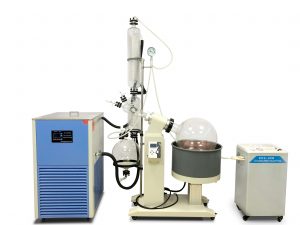[ux_image id=”24533″ height=”58%” lightbox=”true” caption=”true” image_overlay=”rgba(0, 0, 0, 0.04)” image_hover=”zoom” image_hover_alt=”zoom-long”]
[gap]
What is a Rotovap Used for?
A rotary evaporator (rotovap or rotatvap) refers to a kind of equipment for solvent evaporation under reduced pressure. It is primarily used for the process of evaporation, concentration, crystallization, drying, separation, and solvent recovery, and especially used for the continuous distillation of large amounts of volatile solvents under reduced pressure. With so many application purposes, there is no doubt that a rotary evaporator can be applied in many areas. For example, it can be used in the small and pilot experiments and production in the biological, pharmaceutical, chemical fields and even food-making industries.
How does a Rotovap Remove Solvent?
A rotavap evaporates solvents from samples by utilizing the principle that the solvent will have a lower boiling point at a reduced pressure. Specifically speaking, the stepless speed regulation is adopted to make the evaporation flask rotate at a constant speed. By the rotation, materials can form a large area of uniform thin film on the inner wall of the flask. The evaporation flask is heated evenly by a water or oil bath, and materials, with a lower boiling point, is evaporated rapidly under the vacuum condition. The solvent steam is recycled in the receiving flask after being cooled by the high efficiency glass condenser.
Tips on Removing Solvent by a Rotovap
- Users need to remove the gas within equipment to create a vacuum environment, then rotate to prevent the distillation flask from slipping. When you want to stop it, stop rotating firstly. Then hold the flask when you pass the atmosphere into equipment. Stop the vacuum pump until the vacuum gets reduced to 0.04MPa to prevent the distillation flask from falling off and sucking back.
- Each interface, sealing surface, sealing ring and joint needs to be coated with a layer of vacuum grease before installation.
- The heating tank must be filled with water before it is energized. It is not allowed to dry without water.

How does a Rotary Evaporator Work?
1. Preparations
- Pour the mixture of solvent and required compound in a round bottom flask, which should be fiiled less than half full of the solution.
- Fill the rotovap cold traps with dry ice.
- Attach a glass “bump trap” to prevent any solution from entering the main part of the rotovap. Secure with a clip.
- Connect the flask and bump trap to the adaptation part with a clip.
- Lower the flask into the water bath, preventing the flask from disconnection.
2. Operation
The working process of rotary evaporator is a consecutive process under a reduced environment. There are several steps for the operation:
- Under reduced pressure, the evaporation flask was continuously rotated while the solvent was being distilled. The evaporation flask is a pear-shaped or round-bottomed flask with a standard ground mouth connection. It is connected with the pressure reduction pump through a serpentine condenser.
- After substances get evaporated by heating, the gas-phase substances will go into condensing part to get condensed. In this step, gas substances are transferred through the glass tubes.
- After gas-phase substances got condensed into liquid-phase, the liquid-phase substances will be transferred into receiving flask, which is the final destination of extracted substances. And then users will take the receiving flask out of rotary evaporator equipment.
During the whole working process, there is always a vacuum pump providing a vacuum environment for the rotary evaporator, which guarantees the whole system work in a reduced environment and the automatic feeding system formed by the pressure difference between atmosphere pressure and vacuum pressure.
What Three Things Make Rotary Evaporators So Quick at Removing the Solvent from a Round Bottom Flask?
The things influencing the working efficiency of a rotary evaporator include steam temperature, vacuum degree and cooling water temperature. Restricted by some material’s thermolability, the steam temperature may have certain limitation when working, so high vacuum degree and low cooling water temperature are two main factors for efficiency improving (can select cryopump to lower the temperature).
Can a Rotary Evaporator Remove Water?
A rotary evaporator is widely used in removing water from materials, which is to concentrate substances. Removing water by using a rotary evaporator is commonly used in kitchen, for example, concentrate fruit juice, which is to remove water from fruit juice. Besides, there are other examples of removing water from substances.
[title text=”Related Products” tag_name=”h2″ color=”rgb(119, 199, 239)”]
[ux_products ids=”3028,131,56,70″]
[title text=”Related Posts” tag_name=”h2″ color=”rgb(119, 199, 239)”]
[blog_posts style=”vertical” columns=”3″ columns__md=”1″ depth=”2″ slider_nav_style=”simple” slider_nav_position=”outside” ids=”6326,4182,4365″ image_height=”89%” image_width=”43″]